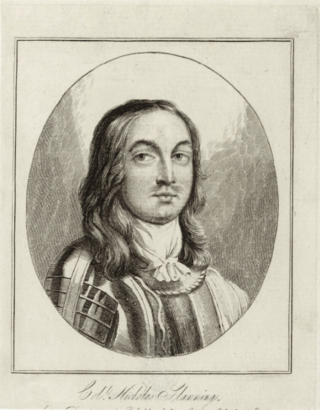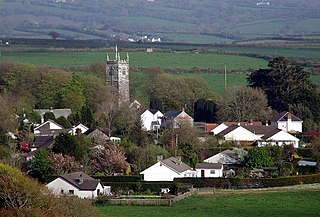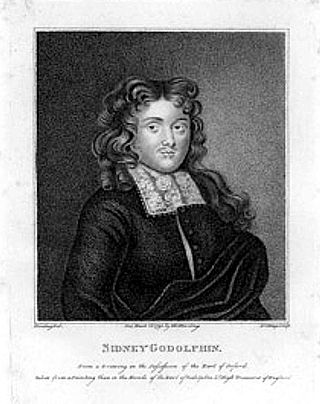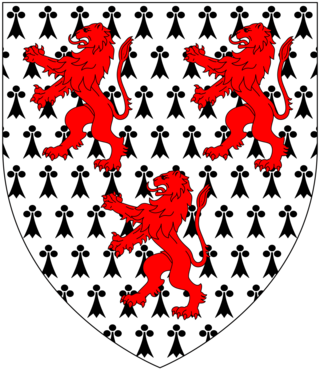
George Monck, 1st Duke of Albemarle KG PC JP was an English soldier, who fought on both sides during the Wars of the Three Kingdoms. A prominent military figure under the Commonwealth, his support was crucial to the Restoration of Charles II in 1660, who rewarded him with the title Duke of Albemarle and other senior positions.

Sir Hardress Waller, was an English Protestant who settled in Ireland and fought for Parliament in the Wars of the Three Kingdoms. A leading member of the radical element within the New Model Army, he signed the death warrant for the Execution of Charles I in 1649; after the Stuart Restoration in 1660, he was condemned to death as a regicide, a sentence commuted to life imprisonment.

Sir Bevil Grenville was an English landowner and soldier who sat as a Member of Parliament for various constituencies between 1620 and 1642, although during those years there were few parliamentary sessions. When the First English Civil War broke out in August 1642, he joined the Royalists and played a leading role in their early campaigns in the West Country. He was killed in action at the Battle of Lansdowne in 1643.

The Vyvyans are a prominent Cornish family who were members of Parliament, baronets, and landowners in Penwith and Kerrier since the 15th century. The Vyvyan family have held the large Trelowarren Estate in the parish of Mawgan-in-Meneage in west Cornwall for nearly 600 years. They moved to Trelowarren in 1427 from Trevegean, St. Buryan when they acquired Trelowarren through marriage to the daughter of Honora Ferrers, heiress to the estate of the previous owner, Richard Ferrers. Trelowarren's first garden is recorded in 1428. In the English Civil War (1642-1651) the Vyvyans were royalist supporters. Sir Richard Vyvyan (1613-1724), 1st Baronet, was given a large equestrian portrait of King Charles I (1600-1649), a copy of the famous painting by Anthony van Dyck, by King Charles II (1630-1685) in recognition of his support.
Callington was a rotten borough in Cornwall which returned two Members of Parliament to the House of Commons in the English and later British Parliament from 1585 to 1832, when it was abolished by the Reform Act 1832.

Sir Nicholas Slanning was a soldier and landowner from Devon who sat in the House of Commons from 1640 to 1642. He served in the Royalist army during the First English Civil War and was mortally wounded at Bristol on 26 July 1643.
John Trevanion (1613–1643) was an English politician who sat in the House of Commons of England from 1640 to 1643. He was a royalist officer who was killed in action in the English Civil War.

Cornwall played a significant role in the English Civil War, being a Royalist enclave in the generally Parliamentarian south-west.

John Arundell, Esquire, of Trerice in Cornwall, later given the epithet "Jack for the King", was a member of an ancient Cornish gentry family, who as a Royalist during the Civil War served King Charles I as Governor of Pendennis Castle, Falmouth. In 1646 he retained the castle in a heroic manner during a five-month-long siege by Fairfax, during which his forces were reduced by hunger to eating their horses, and finally achieved an honourable surrender

John Arundell of Trerice (1613–1644) was a landowner from Cornwall who sat in the House of Commons from 1640 to 1644. He supported the Royalist cause during the First English Civil War and was killed during the Siege of Plymouth in November 1644.

Sir Alexander Carew was an English landowner, soldier and politician from Antony, Cornwall. Elected Member of Parliament for Cornwall in November 1640, he voted for the execution of the Earl of Strafford in May 1641, and supported the removal of bishops from the Church of England.

Richard Arundell, 1st Baron Arundell of Trerice of Trerice in Cornwall, was an English politician who sat in the House of Commons at various times between 1640 and 1664 when he was raised to the peerage. He fought in the Royalist army during the First English Civil War.

Anthony Nicholl was an English politician, friend and associate of Parliamentary leaders John Pym and John Hampden.

Sidney Godolphin, 14 January 1610 (baptised) to 8 February 1643, was a minor poet and courtier from Cornwall who sat in the House of Commons between 1628 and 1643. He served in the Royalist army during the First English Civil War and was killed in a skirmish near Chagford in Devon on 8 February 1643.

William Coryton (1580–1651) of West Newton Ferrers, St Mellion, Cornwall, was a Cornish gentleman who served as MP for Cornwall in 1624, 1626 and 1628, for Liskeard in 1625, for Grampound in 1640 and for Launceston 1640–41. He was expelled from Parliament for falsifying returns.
John Trevanion Purnell Bettesworth-Trevanion was a Cornish politician. He rebuilt Caerhays as a Gothic-style castle.

Thomas Wise of Sydenham in Devon, was an English politician who sat in the House of Commons of England at various times between 1625 and 1641.
Sir William Godolphin was an English soldier and politician who sat in the House of Commons in 1640. He fought for the Royalist cause in the English Civil War.

Sir George Chudleigh, 1st Baronet, of Ashton, Devon, was an English landowner and politician, who sat in the House of Commons at various times between 1601 and 1625. He had close family connections to a group of Devon Presbyterians, including Sir William Strode.













